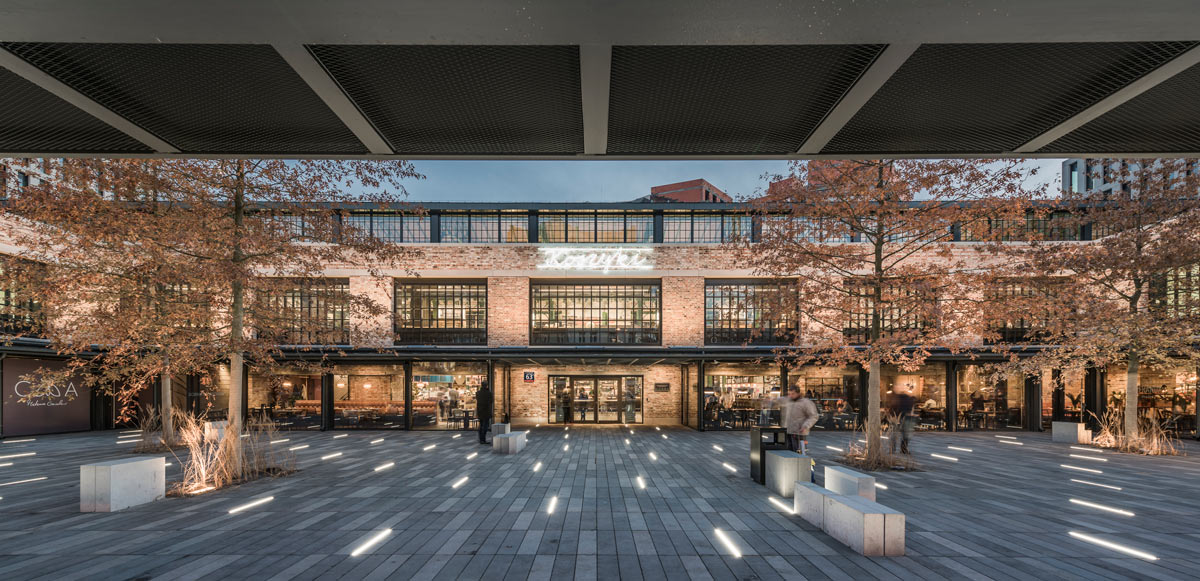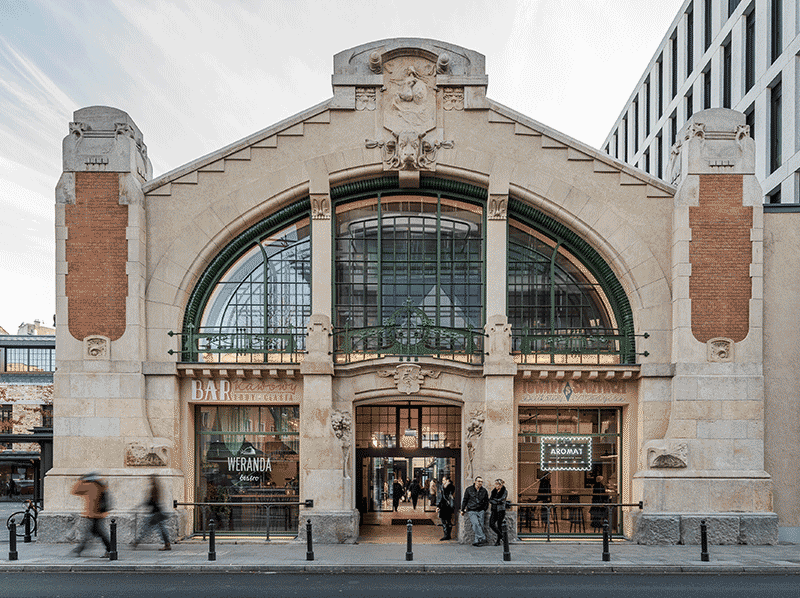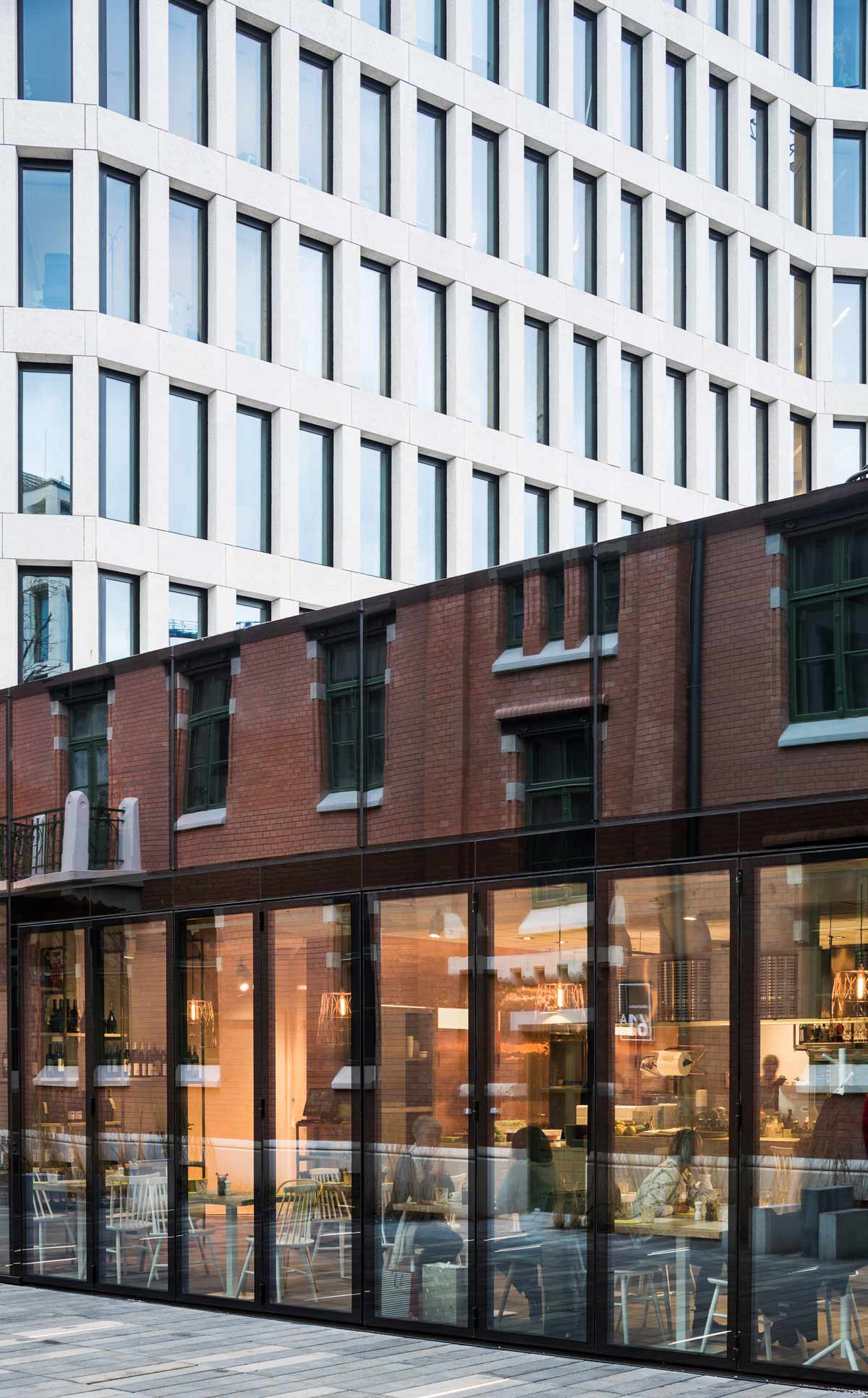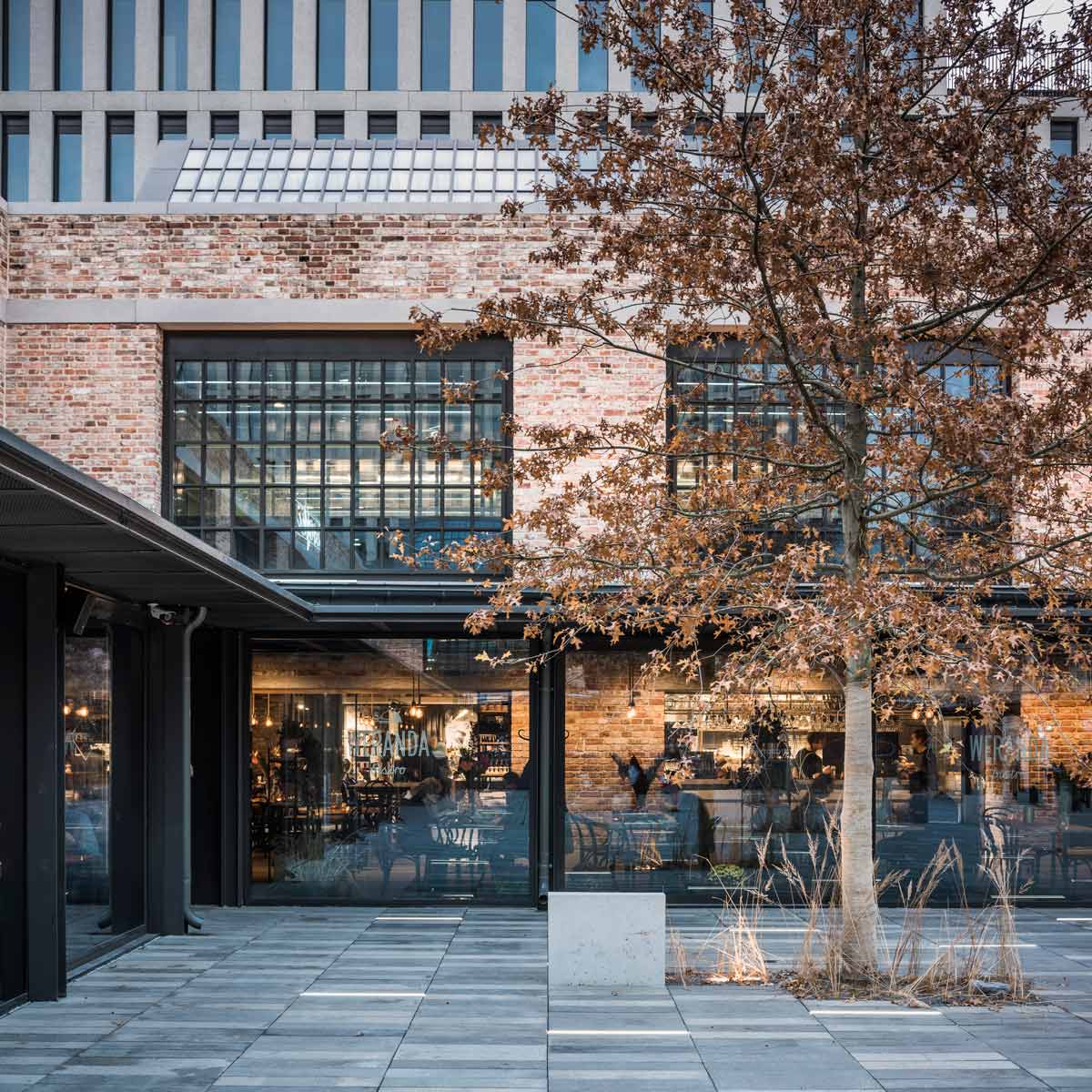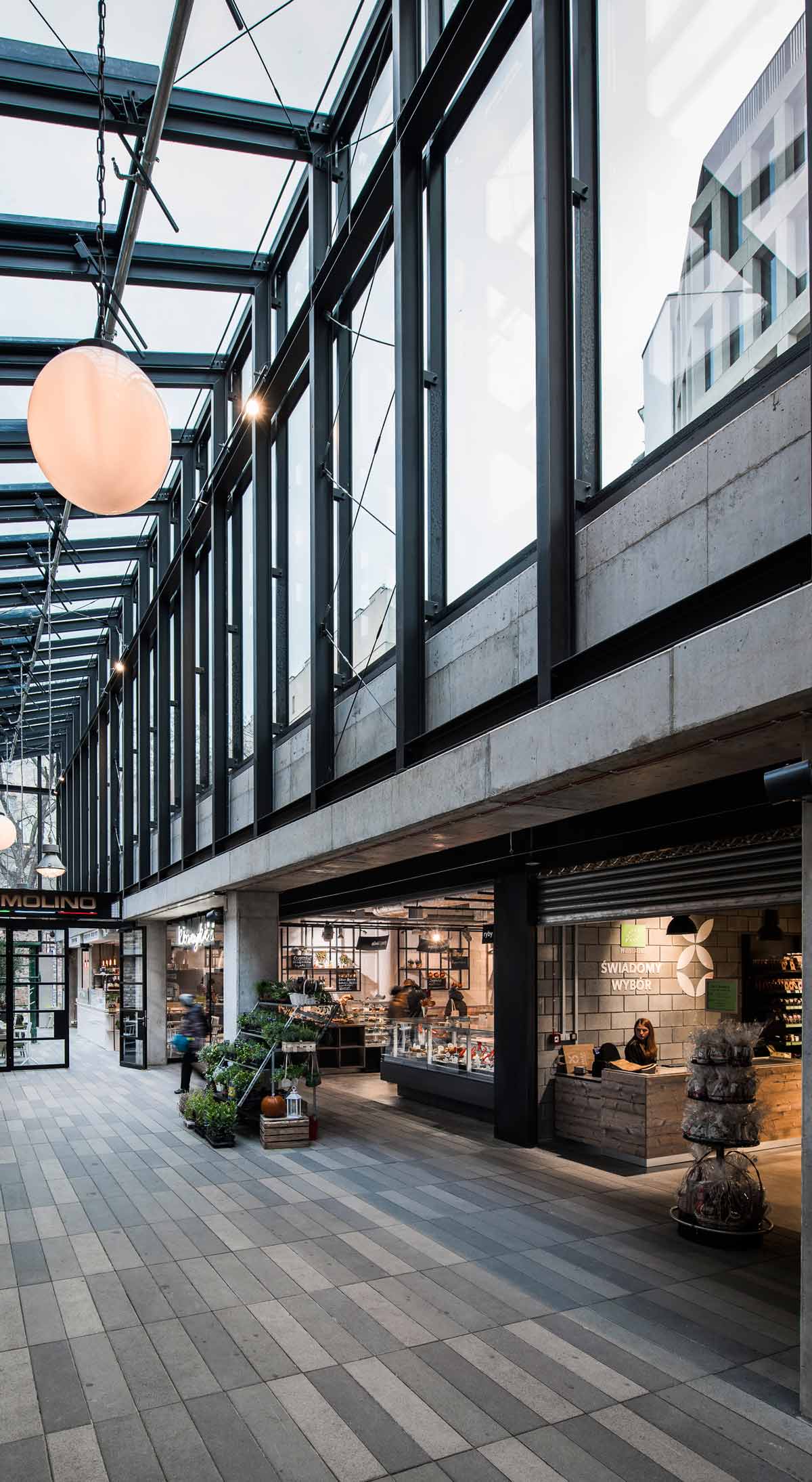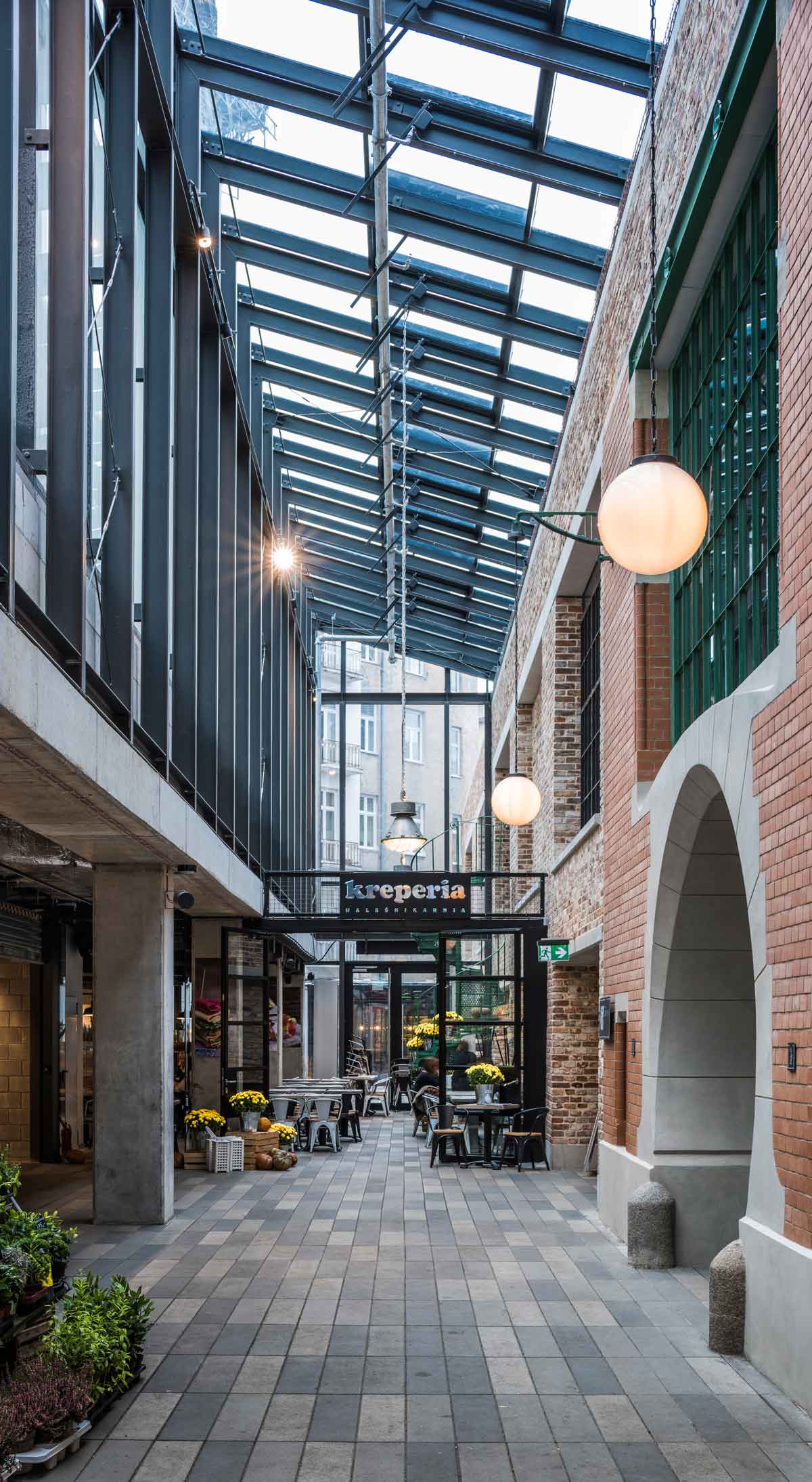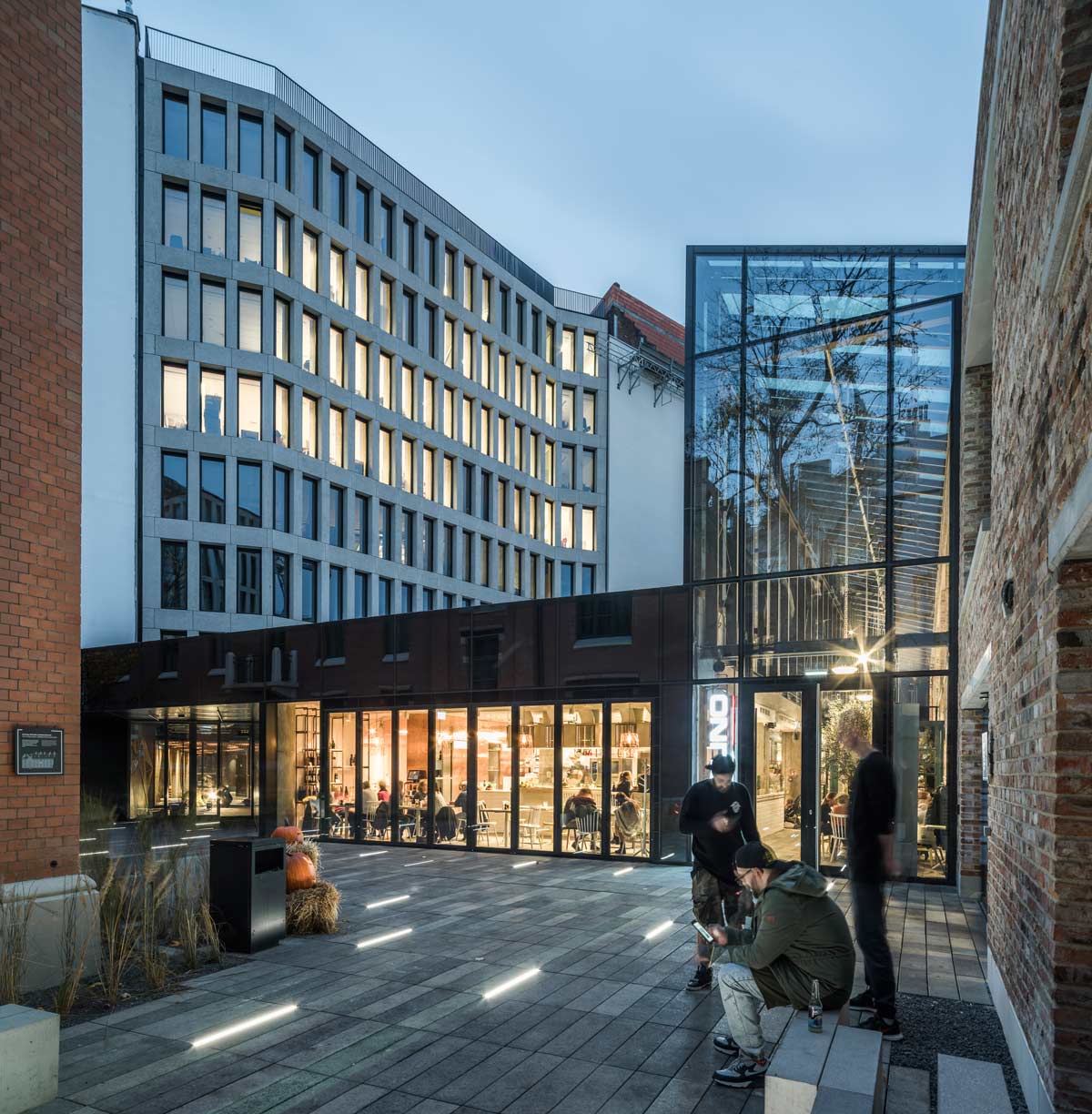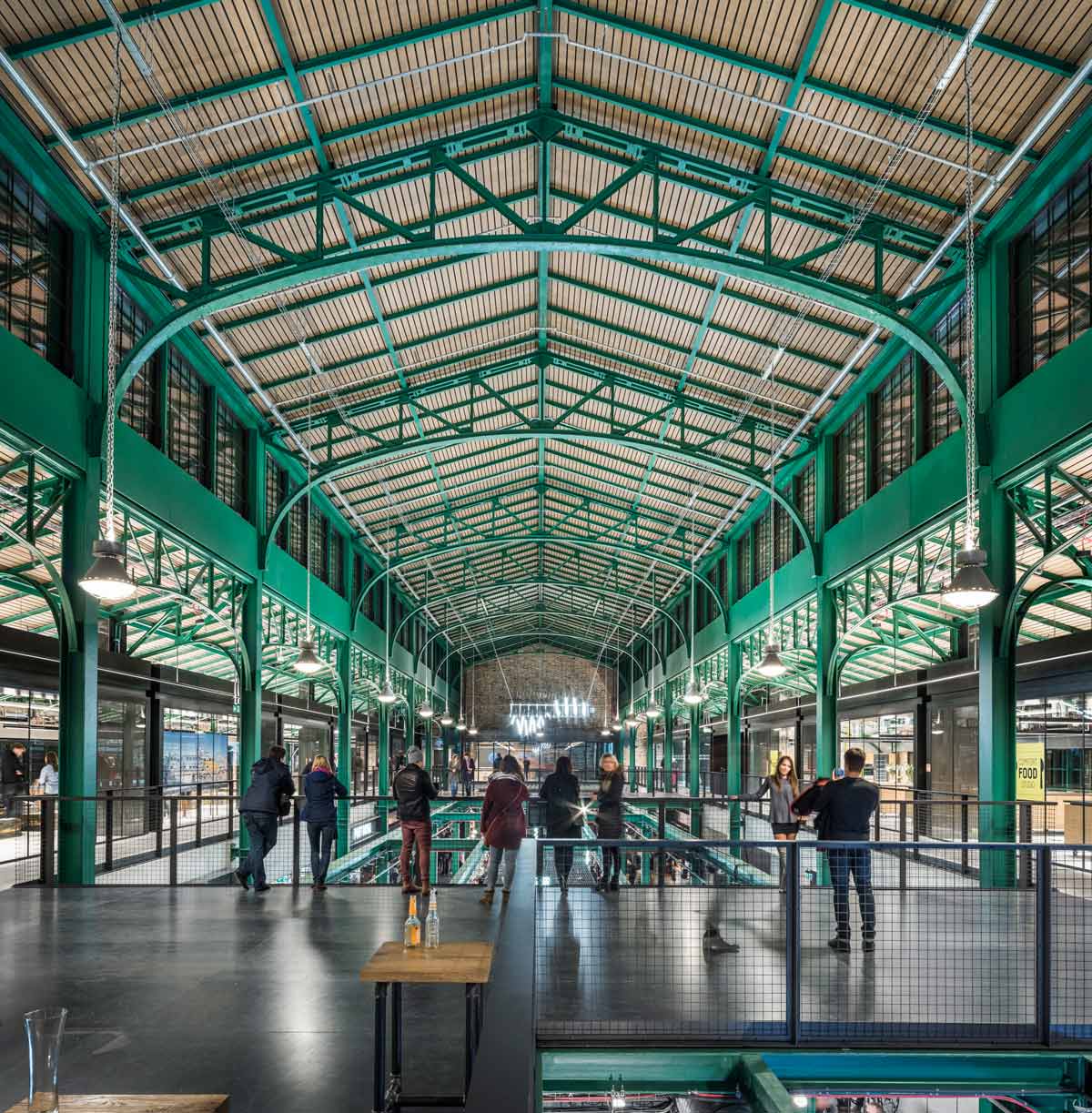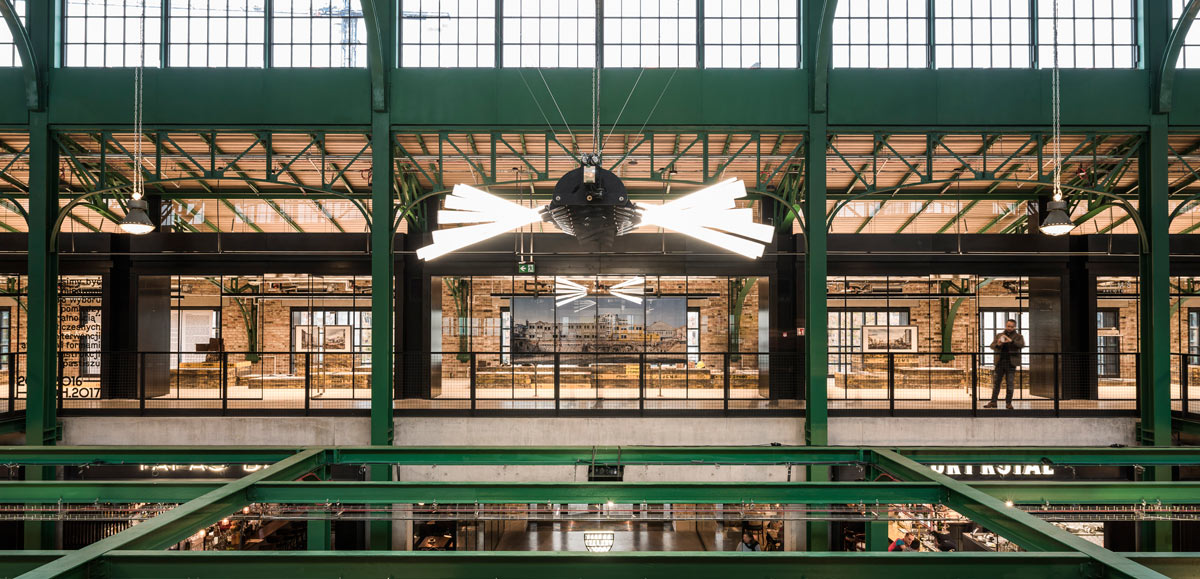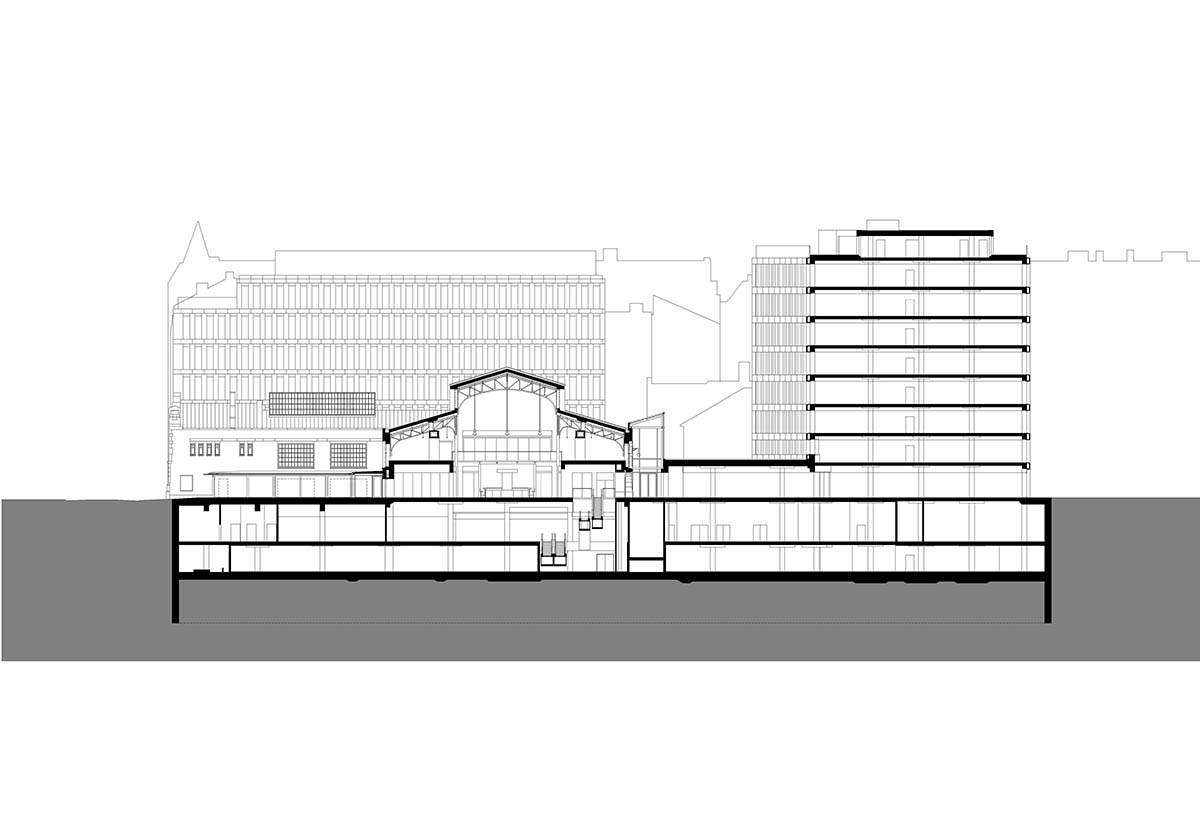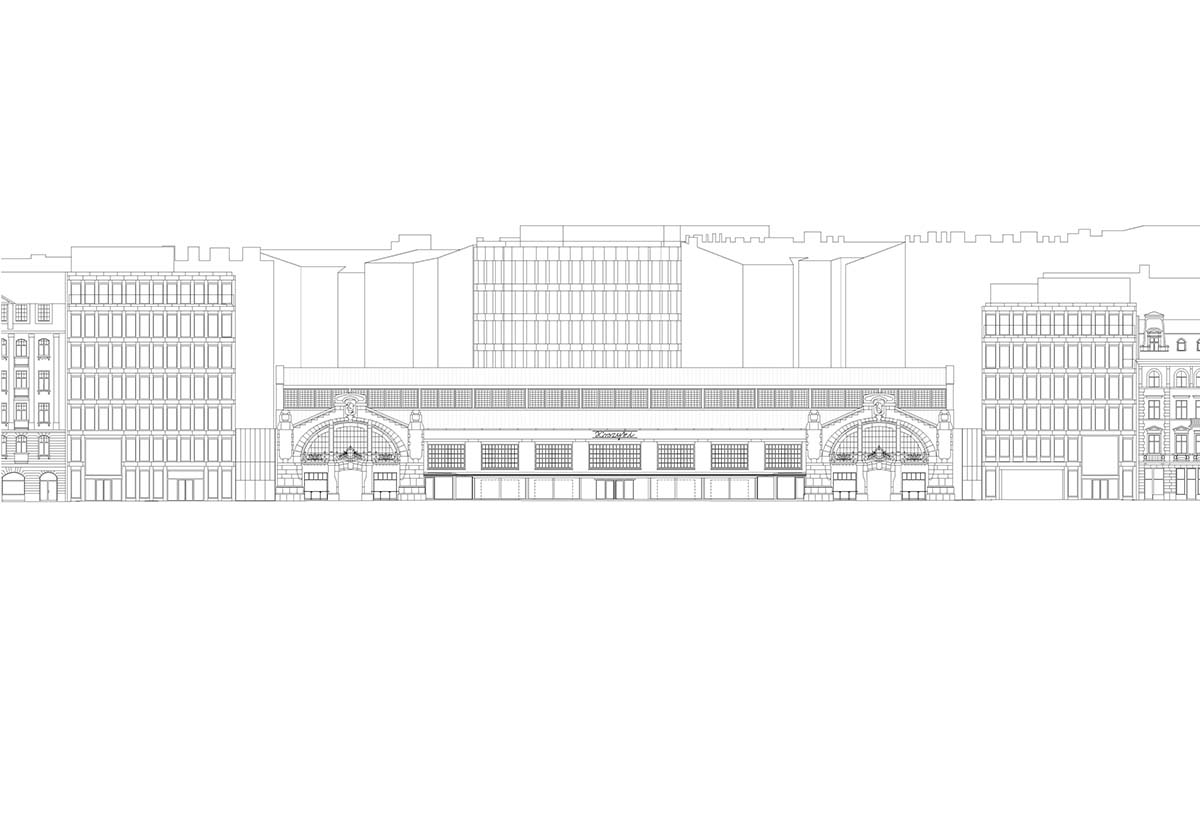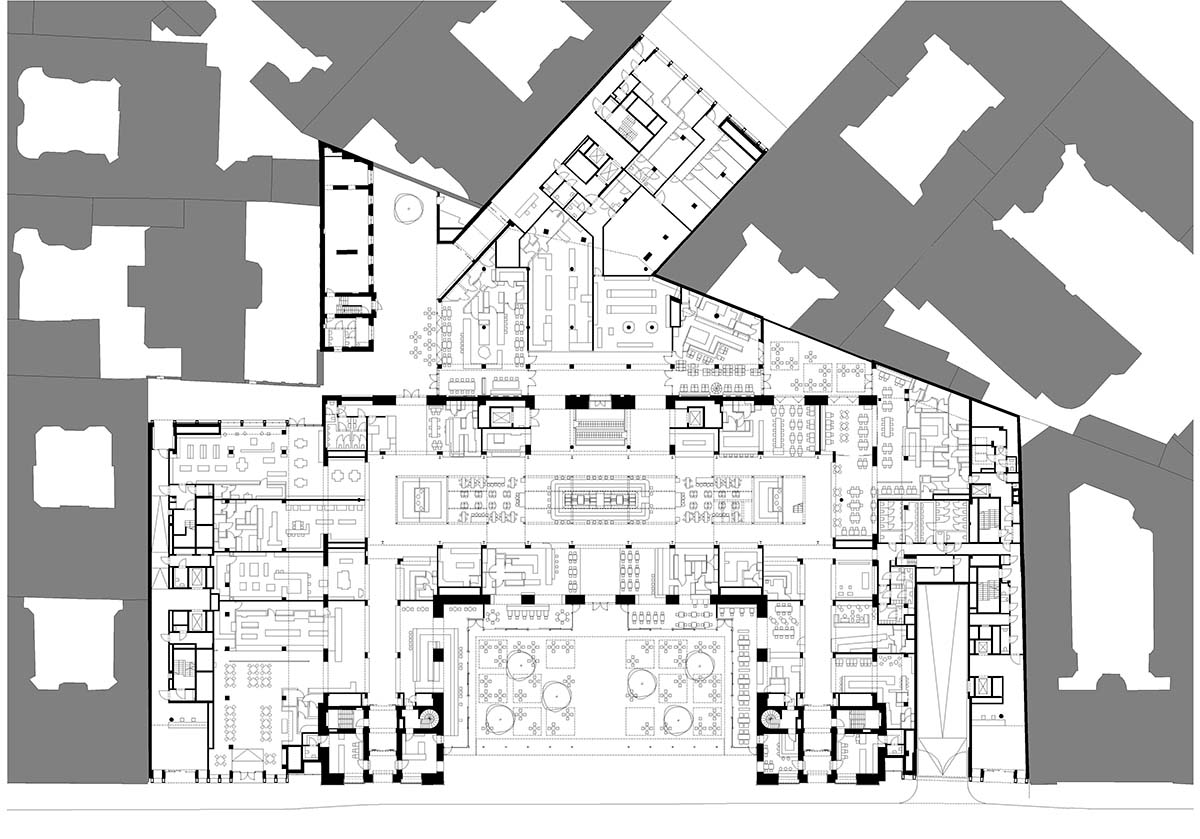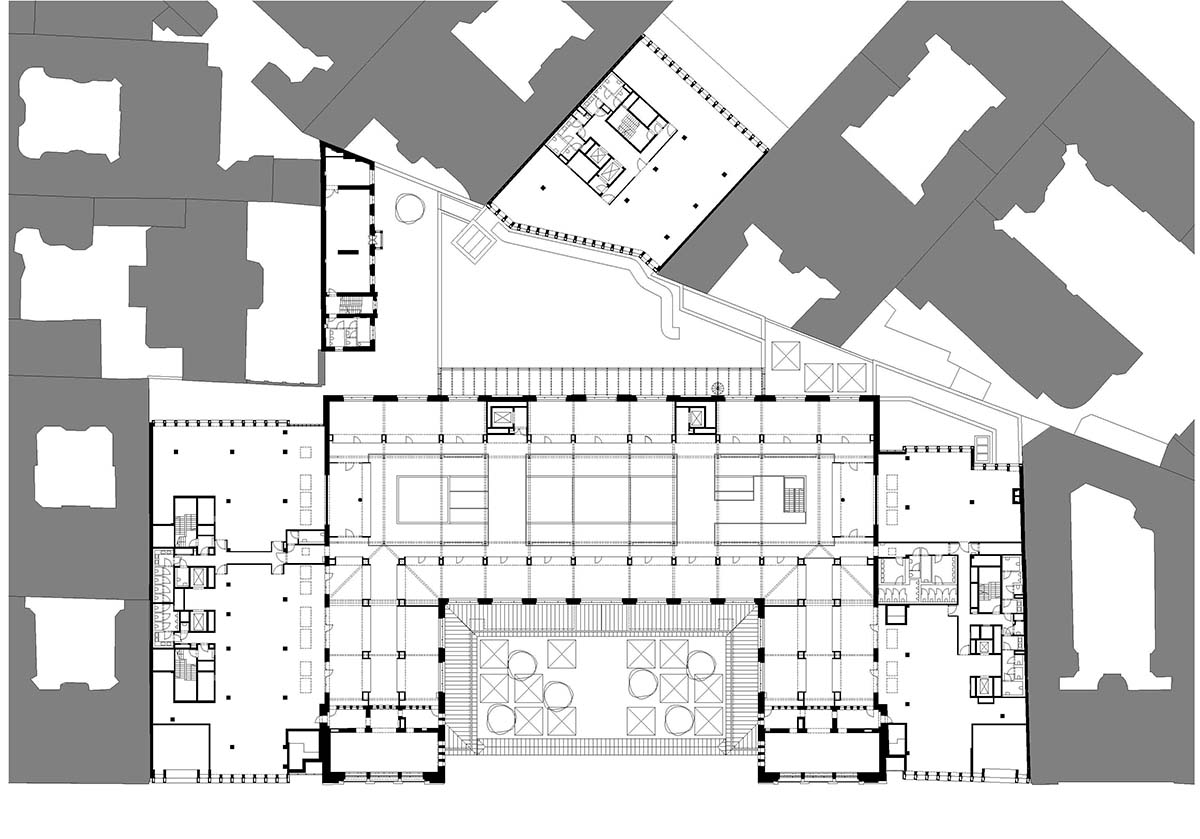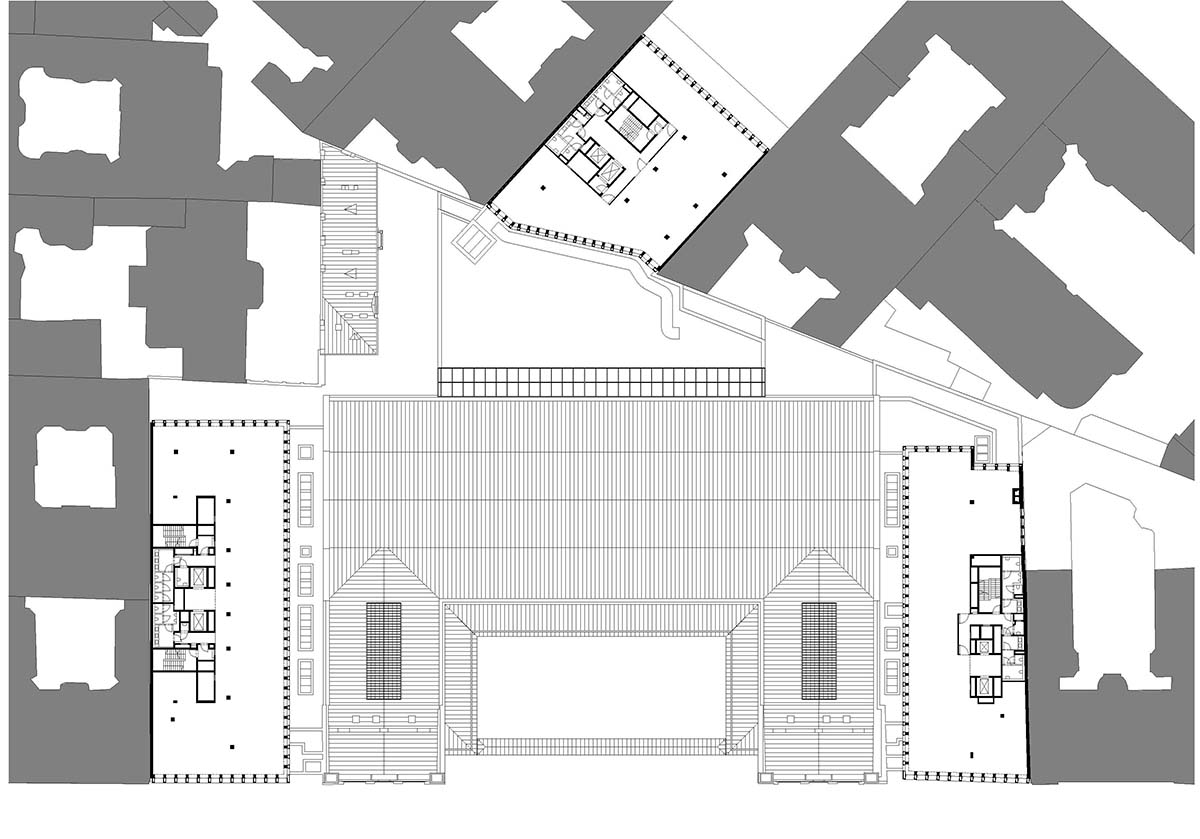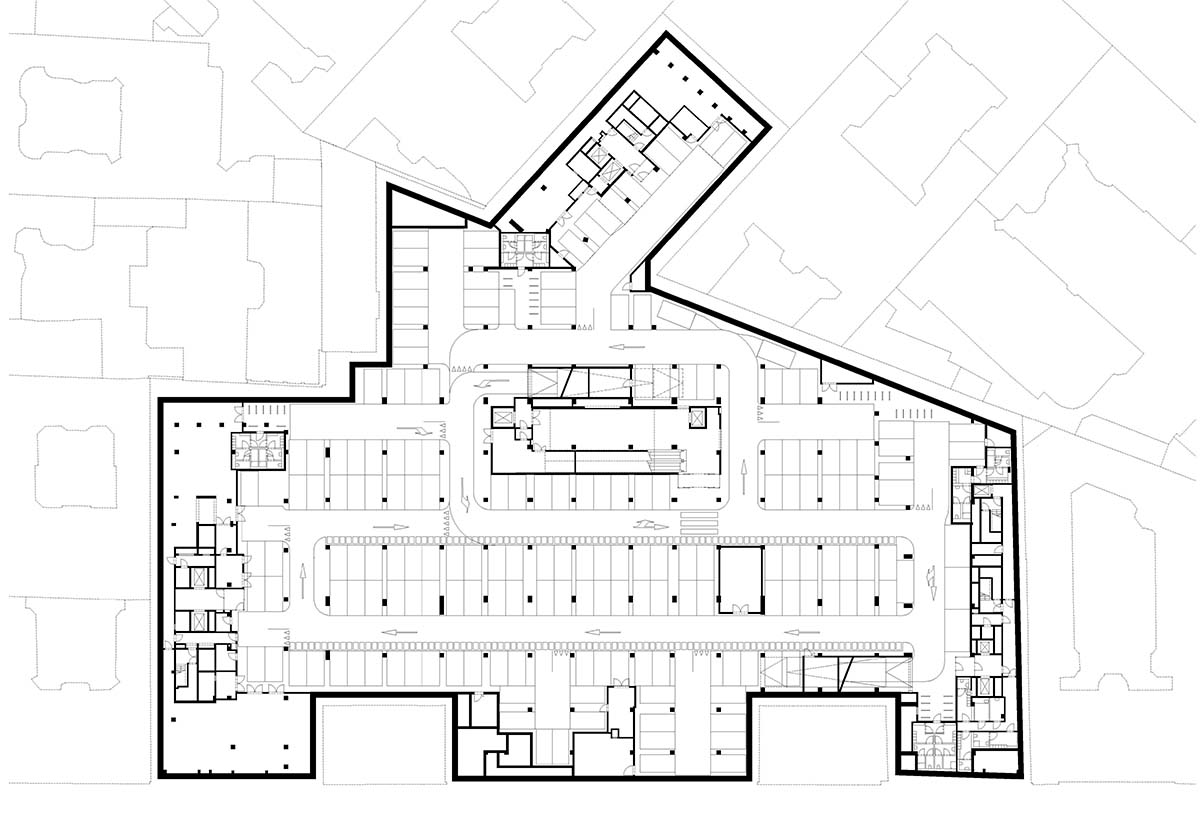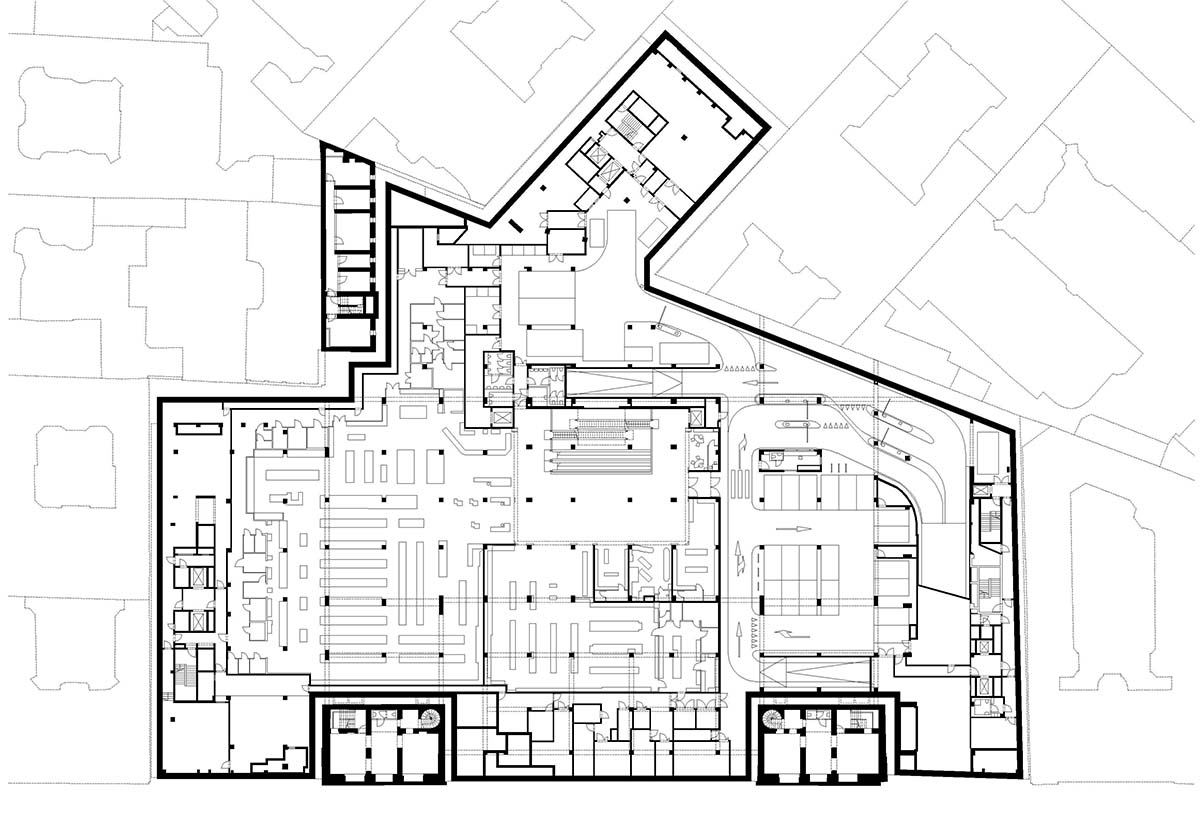HALA KOSZYKI / JEMS ARCHITEKCI
HALA KOSZYKI / JEMS ARCHITEKCI
Stopped Development
The development of the area bounded by Koszykowa, Lwowska and Noakowskiego streets had remained unfinished until our contemporary times. Around the Hala Koszyki market hall built in 1906-09, an area was left built up with one-storey pavilions and warehouses, surrounded by blind gable walls of tenement houses (in which small, chaotically distributed windows were made illegally over time).
The designer's intervention at this place was naturally of a slightly different nature than in the majority of the historic quarters of the downtown area which was gaining shape between the late 19th century and the 1930s, and was largely destroyed during the war. Hala Koszyki had not been built exactly as shown in the preserved drawings by its architect Juliusz Dzierżanowski. Apart from the Art Nouveau gate buildings with Zygmunt Otto's characteristic sculptural decoration, most of the facades were significantly simplified. The location and form of some architectural details was evidently a matter of chance and not of a conscious, holistic idea (e.g. the "Moorish" arched courtyard gate was deprived of an appropriate setting/framing). The Hall that we know from old photographs can hardly be declared an outstanding work of architecture. After the war, Hala Koszyki was rebuilt, with original architectural features of the facades and the interiors largely erased. The reconstruction deprived the hall of most details, its brickwork character, and brought in the chaos of shoddy annexes and canopies. Irrespective of the critical view on the architectural values of the Hall, it must be noted that it became an important, recognisable and characteristic place for Warsaw residents, with which not only the local community identified. The destruction and disassembly of the Hall triggered many sentimental reactions, and the emotions evoked by the reconstruction process testify to an exceptional social significance of the place.
Natural Continuation
When starting design work, we decided there was no room for an uncritical reconstruction of the historic image of the Hall – all the more as virtually no reliable material had survived, based on which this could be done. We did not tackle le-Duc's method of reconstruction of an idealised, beautified version of a historic monument – especially as the Hall had never been "ideal". We also rejected the temptation to strongly highlight the separateness and distinctness of the reconstructed parts – to emphasise their "neutral, contemporary" character – all the more as it is doubtful that anything like this exists. Nor would similar methods, inspired by Alois Reigl's theories, work in the face of greatly mixed authentic and new elements. We believe that the wholeness of the Hall building, its entrance yard, courtyards and passageways is more important than a radical manifestation of division into preserved and reconstructed parts.
The condition of the building's destruction was neither "picturesque" enough nor full of symbolic references to be commemorated/glorified in the reconstruction process. Thus it is not a case similar to David Chipperfield’s Neues Museum in Berlin, although its author's approach to the issue of reconstruction is close to ours in many aspects. The Hall should not be a monument to destruction; instead, it should revoke the former atmosphere and uniqueness of the place as a socially significant space. Cleaned demolition brick used as a "living, three-dimensional" facade material is intended to discreetly bring back the lost brickwork character of the Hall, integrate its preserved and reconstructed components into a compositional whole rather than evoke associations with its stormy past.
We sometimes provisionally call our approach to activities involving historic buildings the process of NATURAL, CRITICAL CONTINUATION. We believe we do not have to make a choice between the "neutrality" of contemporary interventions (neutrality being a doctrinaire abstract rather than a real possibility) and different forms of reconstruction or pastiche. Viollet-le-Duc's interventions beautifying historic monuments have wreaked much havoc, and his "faithful-to-the-period" reconstructions exude a lack of authenticity even for moderately educated audience, as do some of the rebuilt tenements in Warsaw's Royal Route, sanitised by elements of socialist realist aesthetics. Besides, we do not consider it appropriate to seek a compromise between those popular positions disseminated during the past two centuries. We try to take an individual approach to every job, taking into account the legacy image of a historic site, lessons of old and contemporary architecture, our capabilities and skills, an open-minded, respectful but not uncritical attitude to a historic monument, available techniques, our intuitions and the client's objectives. It is not a rule, doctrine or standards captured in charters or manifestos, but the abilities and culture of builders, designers and investors, their open attitude to new challenges, that have always determined the success or failure of reconstruction, addition or renovation projects. The sgraffito in the castle courtyards in Cesky Krumlov, its Renaissance bridges/galleries, are something different from the coarse, organic external defence walls rising from the rock, erected and built up over several preceding centuries. However, they form a harmonious whole, as do the Wawel walls when juxtaposed with the arcaded courtyard and subsequent interventions by Szyszko Bohusz. Certainly enough, historical reconstruction and expansion projects have not always been an architectural success. The Renaissance chapel inserted between the Gothic spires of the Angers Cathedral has damaged its slender proportions, while it might seem interesting in itself. The history of Hala Koszyki unfolded over a period of just over a hundred years. It was not only a string of successes but also of numerous failures. Various changes and conversions altered its character, usually in an adverse manner. Due to the nature of the site, architectural efforts were usually subordinated to ad-hoc requirements of the economy.
The Design
Our design seeks to highlight whatever is authentic and preserved in the building, that is, the entrance gate buildings, the dimensions and massing of the main building body, its steel structure (a new structure designed to contemporary standards plays merely a supporting role), various details, and elements of ceramic flooring.
The re-incorporated historic elements (demolition brick, trusswork, ceramic materials) have been given a backdrop of natural materials (formwork concrete, hot-rolled steel, brush-painted steel, wooden soffit, concrete screed, mesh) without any beautification or exaggerated manifestation of workmanship accuracy, all in line with our conception of the market hall ambience. At the same time, we have made many changes that we believe enhance the values of the Hall, especially of its interiors, which are now e.g. provided with additional openings in the external walls of the Hall's ground floor areas, allowing insight into the interiors of the building/quarter. The new formula of the external extensions – "stalls" linked with the interior – integrate the building with the internal courtyard transformed into an attractive public space. The lack of fencing and multiple entrance options make the building open and accessible. A new passageway has been created at the back of the Hall, spread between two external patios/gardens, whose attraction is a renovated axial portal and a former house of the Hall director - the outbuilding.
The Hall has also been provided with a new background consisting of three office/commercial buildings that supplement the Koszykowa Street development and organise the space of the courtyards which, expanding the idea of dense development, have become a network of passageways, courtyards and galleries well connected visually with the public space of the street and the entrance yard. The deep, massive, light-and-shade facades of the new buildings, made of precast concrete units, when viewed along Koszykowa Street, have become a natural supplement to the street frontage, harmonising with the plastered, detail-rich tenement houses of the neighbourhood.
The New Formula
Restoration of the function of the Hall as a place associated with food, being close to its original marketplace character, required, in our opinion, the creation of strong architectural formula that delivers diverse manifestations of life only when filled with cafes, bars and restaurants. This is why even today we do not think the Hall is a finished work. We bear in mind Rem Koolhaas's claim that a building has at least two lives - the one imagined by its maker and the life it lives afterward – and they are never the same. We are hoping that completion of the construction project will mark another beginning for this important Warsaw spot, and that the proposed architectural form will serve the purpose well.
Why brick?
The historic building originally was plastered and covered with ceramic tiles. Dismantled almost completely and reassembled, it underwent a profound transformation resulting from a vigorous change process. The exposed original demolition brick offers living in an "unfinished" space and symbolises opening up to further conversions.
Extra info
| Site: | Warsaw, Poland |
| Architect: | JEMS ARCHITEKCI (Olgierd Jagiełło, Maciej Miłobędzki, Marcin Sadowski, Jerzy Szczepanik-Dzikowski, Paweł Majkusiak, Mateusz Świętorzecki, Mieszko Burmas, Urszula Kos, Piotr Lisowski, Maria Mermer, Katarzyna Piotrowska) |
| Collaborators: | co-author of the hall interior and the area, author of parts of the common offices MEDUSAGROUP ( Przemysław Łukasik, Dorota Pala) |
| Project start date: | October 2012 |
| Construction years: | August 2015- October 2016 |




